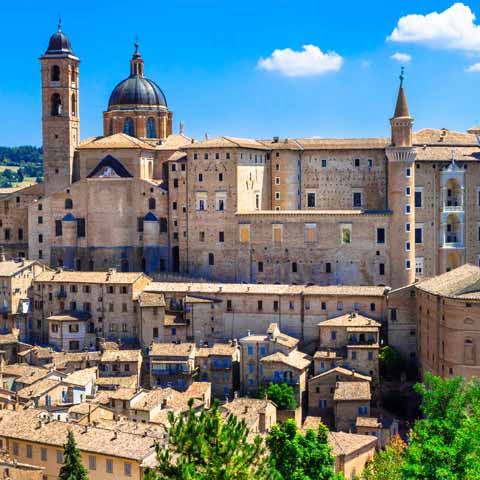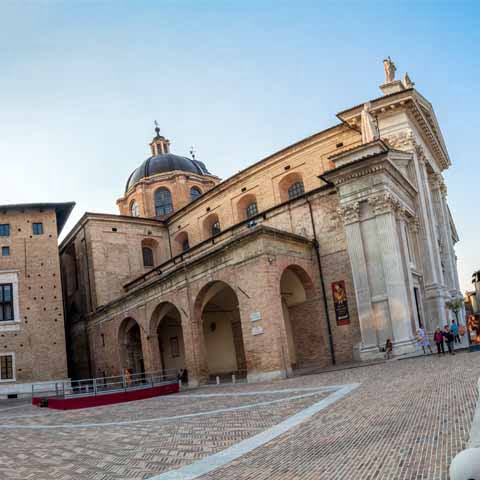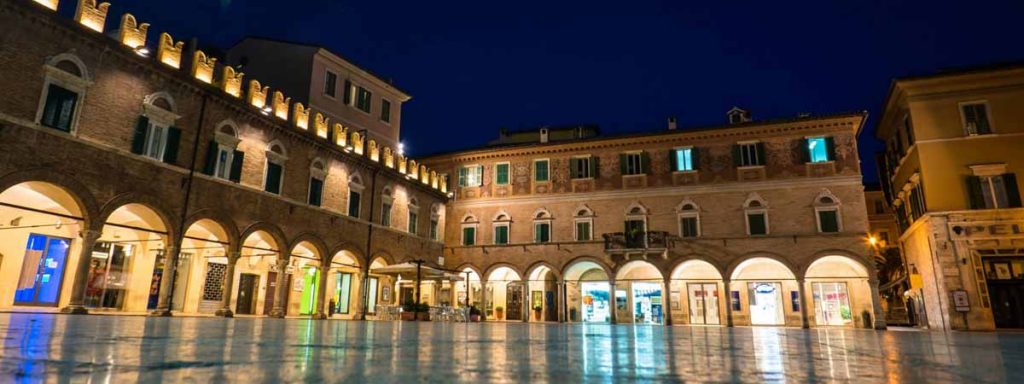Urbino is a small Italian town and the co-capital of the province of Pesaro and Urbino. One of the most important Italian centers during the Renaissance, the town now impresses with a vast artistic and architectural heritage.
Its Old Town has been a UNESCO World Heritage Site since 1998. Given its artistic importance, Urbino is memorialized in the series of sculptures that are part of the Vittoriano Monument in Rome and represent the fourteen noble cities of united Italy.
The name of the town has uncertain origins. According to some historians, it derives from the Latin name Urvinum Mataurense. Urvinum, at its turn, derives from the noun urvum, which indicated the handle of the plow, whose shape resembled the hill of Poggio, the site of the primitive nucleus of the future settlement. The Romans added the term Mataurense, referring to the nearby Metauro River, to the Latin name to distinguish Urbino from another homonymous city located in the same Augustan region, Urvinum Hortense.
According to an alternative hypothesis though, it is believed that the name derives from the Latin Urbis, meaning city, and refers to the double nature of the city urbs-bina, with bina meaning pair, because it developed on two hills.
Only a few scholars would claim that the name has pre-Roman origins, but there is little evidence to sustain this theory.
In either case, Urbino rose to prominence during the Renaissance and today the art and architecture from Urbino’s prime can still be admired throughout the historic city center.
PREHISTORY OF URBINO
The history of Urbino has its roots lost in the depths of time; the first populations to ever settle in the region were the Umbrian-Piceno civilizations. However, there is too little evidence to understand which cultures shaped the future of the early settlement.
Urbino, as we know it today, developed from an ancient fortified city, conquered by the Romans and named Urvinum Mataurense.
The town became a municipium in 46 BC when it already had a certain urban consistency.
However, Urbino did not play a significant role on the Roman scene. In fact, it only became important towards the end of the Roman Empire, during the Gothic Wars.
HISTORY OF URBINO
After the fall of the Western Roman Empire, Urbino passed under the Byzantines in 538 AD. It then passed under the dominion of the Lombards and then of the Franks. The Franks saw in Urbino an opportunity to gain the favor of the Papal States, so the town was offered to the Papacy.
Nevertheless, the independent and autonomous traditions of this settlement caused the citizens to create their own government, which ruled the municipality until the thirteenth century, when it fell under the dominion of the nobles of Montefeltro.
Although they had no direct authority over the municipality, the Montefeltro family started to exert pressure regarding the election of a Podestà, a title ultimately granted to Bonconte da Montefeltro in 1213.
As a result, Urbino rebelled against the new governor and formed an alliance with the independent municipality of Rimini. With their help, in 1234, the citizens regained control of their city.
Subsequently, however, the Montefeltro succeeded in taking back the reins of the city and controlled it until the beginning of the sixteenth century.
During this period, Urbino gained the aspect it still has today, including the imposing city walls.
In the battles between the Guelph and Ghibelline factions, the lords of Urbino supported the latter and became leaders of the Ghibellines in both the Marche and Romagna regions.
Perhaps the most famous exponent of the Montefeltro family was Federico, Duke of Urbino between 1444 and 1482. A successful leader and skilled diplomat, as well as an enthusiastic patron of arts and literature, he worked on solving the political problems of the time and began a reorganization of the state, which also included a major restructuring of the city according to the modern, more comfortable canons of the era.
All his efforts in the nearly 40 years of government were aimed towards making Urbino a flowering settlement, and the results can still be admired in many of the remarkable buildings of the city.
But the era of Montefeltro was close to its end, and in 1502, Cesare Borgia ousted Duke Guidobaldo da Montefeltro (Federico’s son) with the help of Borgia’s father, Pope Alexander VI. Urbino remained under Cesare Borgia until the death of Pope Alexander VI. At which point, Guidobaldo returned to Urbino and named his nephew, Francesco Maria Della Rovere as his heir. This began the rule of the dukes of Della Rovere from 1508 to 1625, with a brief Medici interlude from 1516 to 1519.
The new dukes transferred the court from Urbino to Pesaro, and the former entered into a period of slow decline that would last until the end of the seventeenth century.
Furthermore, during the sixteenth century, due to the perennial struggles between the Republic of Venice and the League of Cambrai (backed by the Papal States), Urbino was involved in the war on several occasions.
With the end of the Della Rovere dynasty in 1625, Pope Urban VIII incorporated the Duchy of Urbino into the papal territories, following the wishes of the last duke, Francesco Maria II Della Rovere, who, due to a lack of heirs, designated the Holy See as his successor.
Under the new government, Urbino was ruled by a papal legate bound to the ecclesiastical hierarchy and designated to exert administrative control.
Following the devolution of the Duchy under the Papal States, the rich artistic heritage of the Palazzo Ducale constituted, for the most part, the dowry of the last direct descendant of the Della Rovere, Vittoria, who married Ferdinando II de Medici. Subsequently, all these works would become the core of the future Uffizi Gallery in Florence.
Among the many works that went to Florence, was the Diptych of the Dukes of Urbino by Piero della Francesca. Other works, originally belonging to the Palazzo Ducale, were eventually moved to Rome, including a famous library which was entirely absorbed by the Vatican in 1657.
The eighteenth century opened with the election of a new Pope, Urbino-born Cardinal Giovanni Francesco Albani, who chose the name Clement XI. This opened up the last great season of splendor for Urbino, above all from an artistic and cultural point of view.
Thanks to the financing of Pope Clement XI, the town carried out numerous renovation works, which included the restoration of various buildings, churches, and monasteries. Some of these edifices included Palazzo Albani, part of the façade of Palazzo Comunale, some parts of the Convent of San Francesco, the Oratory of San Giuseppe, alongside the restructuring of the churches of San Domenico, San Francesco, and Sant’Agostino.
At the same time, new buildings emerged and artisan craftsmanship was promoted. Furthermore, the patronage of the Pope and his family was reflected in rich donations to the Cathedral, which received a new altar, and to other religious institutions in the town.
This age of splendor ended with the death of Clement XI in 1721, when Urbino entered a long period of decline that has spread over the centuries.
Even after the Pope’s death, the Albani family would remain the main commissioner of the most important works in Urbino until the first half of the nineteenth century.
At the end of the eighteenth century, following a powerful earthquake that struck Urbino, the dome of the Cathedral collapsed, an event that led to the total reconstruction of the church.
Merely ten years later, the city was occupied by the French troops, just like most of Central and Northern Italy. During the French occupation, the city lost important works of art that were displaced to either Paris or Milan, in the nascent galleries of the Louvre and Brera, respectively.
This event led to further impoverishment of the local artistic heritage, following the loss that occurred during the devolution of the Duchy in the seventeenth century.
The nineteenth century opened with the consecration of the new Cathedral, rebuilt according to the project of the architect Giuseppe Valadier. Valadier was renowned at the time for having restored many important buildings in the city of Fermo, such as the ancient Seminary; and indeed, the new Cathedral turned into a true masterpiece.
At the same time, the nobleman Fulvio Corboli planned a first urban renewal project developed to create a link between the inland town and the coastal area.
Despite the slow decline, Urbino gained many new buildings during the nineteenth century, including Palazzo Nuovo degli Albani, the current Piazza della Repubblica, and the first section of the future Corso Garibaldi.
These last urban transformations greatly improved access to the town that no longer depended on crossing city walls or traversing narrow, winding streets.
The new urban plan favored the entrance of the Piedmont troops in Urbino on September 8, 1860, forcing the last resistance of the Pontifical Army to surrender under the arcade of the Collegio Raffaello. Then, the troops proceeded with the conquest of Ancona and of the entire Marche region.
As a result, a referendum was held for the annexation of Marche to the Kingdom of Sardinia, which happened on December 17, 1860.
The new government proceeded with the confiscation of various ecclesiastical assets, including many artworks from the Convent of San Francesco and the Monastery of Santa Chiara.
The twentieth century brought an impressive bloom of artistic and cultural activity, which included the growth of the university and the emergence of the School of Pharmacy.
Consequent to the evolution of the University, the town also witnessed strong demographical growth due to the students coming here to pursue their degrees.
This highlighted the unpreparedness of the town due to the scarcity of housing. The crisis was so severe that many students were housed by private citizens. The problem was partly solved by 1926, but the advent of the fascist regime, which inevitably involved Urbino, led to new challenges.
Nevertheless, the fascists did not hinder the cultural development of the city and even contributed to it. During this period, Urbino received a new elementary school, built on the ancient Garden of Santa Lucia, and a new student house to make up for the scarcity of housing. Infrastructure works also included the modernization of the municipal water network.
In 1938, Urbino was designated the headquarters of the newly created Superintendence for the Galleries and Works of Art of Marche.
Luckily, Urbino suffered no serious damage during World War II, thanks to a conventional signal painted on the roof of Palazzo Ducale and to the tacit agreement between the German troops and the Allies.
Only during the retreat of the German army, Urbino suffered the destruction of the rail and road connections.
Thanks to this tacit agreement though, Urbino was able to save over 10,000 artworks belonging to many renowned Italian artists, including Titian and Raphael.
The Nazi troops were forced out of Urbino on August 28, 1944, by the British Army and Polish troops, and the partisan groups in the area also contributed to the event.
In the second half of the century, the University and Municipality started to collaborate in a massive restructuring project aimed at recovering the historic center, which had been left in bad condition during the long period of urban decline.
The project improved the town’s appearance, and today, the settlement focuses on the development of its university and tourism sectors, thanks to its valuable old town that is a UNESCO World Heritage Site.
ARCHAEOLOGY OF URBINO
Despite its ancient history, archeological evidence is rather scarce in Urbino. Some archeological sites in the province of Pesaro-Urbino include the amphitheater of Fanum Fortunae in Fano and the archaeological area of Sant’Agostino.
Having focused most of its history on the development of arts, Urbino also lacks an archaeological museum. Nevertheless, the Lapidario Museum has a section dedicated to archaeology.
Some remains in Urbino from the Roman Age include a monumental tomb and the ruins of a Roman amphitheater.
Don't just see Italy, live it.
Your dream trip to Italy has never been closer
No more endlessly scrolling travel sites. Our travel experts will craft the perfect, one-of-a-kind trip just for you.

300+
DESTINATIONS
We offer more Italian destinations than any travel site. Do and see more with Trips 2 Italy.
1 (of a kind)
ITINERARIES
Because your dream trip to Italy should be designed for you, not for the masses.
100%
PEACE OF MIND
From flights and accommodations, to food and activities - we take care of every detail.



